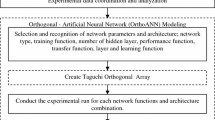Abstract
In the present study, a second order multi-variable regression model and a feed-forward back-propagation neural network (BPNN) model have been developed to correlate the input process parameters, such as pulse on-time, pulse off-time, peak current, and capacitance with the performance measures namely, cutting speed and surface roughness while wire electro-discharge machining (WEDM) of tungsten carbide-cobalt (WC-Co) composite material. From a large number of neural network architectures, 4-11-2 has been found to be the optimal one, which can predict cutting speed and surface roughness with 3.29% overall mean prediction error. The multivariable regression model yields an overall mean prediction error of 6.02%. Both the models have been used to study the effect of input parameters on the cutting speed and surface roughness, and finally to corroborate them with those of the experimental results. Scanning electron micrographs reveal that at higher energy level the machined surface is characterized by several microcracks and loosely bound solidified WC grains.
Similar content being viewed by others
References
Mahdavinejad RA, Mahdavinejad A (2005) ED machining of WC-Co. J Mater Process Technol 162–163:637–643
Haykin S (2002) Neural networks: a comprehensive foundation. Pearson, Harlow
Gadalla AM, Tsai W (1989) Electrical discharge machining of tungsten carbide-cobalt composite. J Am Ceram Soc 72(8):1396–1401
Lee SH, Li XP (2001) Study of the effect of machining parameters on the machining characteristics in electrical discharge machining of tungsten carbide. J Mater Process Technol 115:344–358
Lee SH, Li X (2003) Study on the surface integrity on the machined work piece in the EDM of tungsten carbide. J Mater Process Technol 139:315–321
Scott D, Boyina S, Rajurkar KP (1991) Analysis and optimization of parameter combinations in wire electrical discharge machining. Int J Prod Res 29(11):2189–2207
Sarkar S, Mitra S, Bhattacharyya B (2005) Parametric analysis and optimization of wire electrical discharge machining of γ-titanium aluminide alloy. J Mater Process Technol 159:286–294
Liao YS, Huang JT, Su HC (1997) A study on the machining-parameters optimization of wire electrical discharge machining. J Mater Process Technol 71:487–493
Karthikeyan R, Narayanan PRL, Naagarazan RS (1999) Mathematical modeling for electric discharge machining of alumimium-silicon carbide particulate composites. J Mater Process Technol 87:59–63
Trang YS, Ma SC, Chung LK (1995) Determination of optimal cutting parameters in wire electrical discharge machining. Int J Mach Tools Manuf 35(12):1693–1701
Sarkar S, Mitra S, Bhattacharyya B (2006) Parametric optimization of wire electrical discharge machining of γ titanium aluminide alloy through an artificial neural network model. Int J Adv Manuf Technol 27(5–6):501–508
Spedding TA, Wang ZQ (1997) Study on modeling of wire EDM process. J Mater Process Technol 69:18–28
Spedding TA, Wang ZQ (1997) Parametric optimization and surface characterization of wire electrical discharge machining process. Precis Eng 20:5–15
Tsai KM, Wang PJ (2001) Predictions on surface finish in electrical discharge machining based upon neural network models. Int J Mach Tools Manuf 41:1385–1403
Tsai KM, Wang PJ (2001) Comparisons of neural network models on material removal rate in electrical discharge machining. J Mater Process Technol 117:111–124
Saha P, Singha A, Pal SK, Saha P (2007) A neural network approach for modeling the wire electro-discharge machining of tungsten carbide cobalt composite. Proc Global Conference on Production and Industrial Engineering (CPIE-2007), India, pp 38
Author information
Authors and Affiliations
Corresponding author
Rights and permissions
About this article
Cite this article
Saha, P., Singha, A., Pal, S.K. et al. Soft computing models based prediction of cutting speed and surface roughness in wire electro-discharge machining of tungsten carbide cobalt composite. Int J Adv Manuf Technol 39, 74–84 (2008). https://doi.org/10.1007/s00170-007-1200-z
Received:
Accepted:
Published:
Issue Date:
DOI: https://doi.org/10.1007/s00170-007-1200-z




